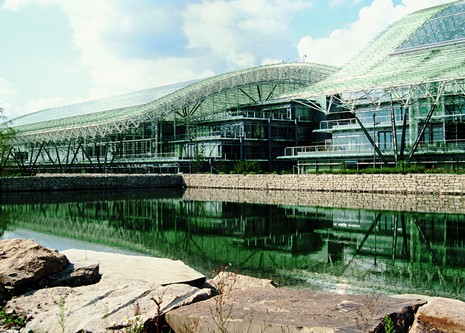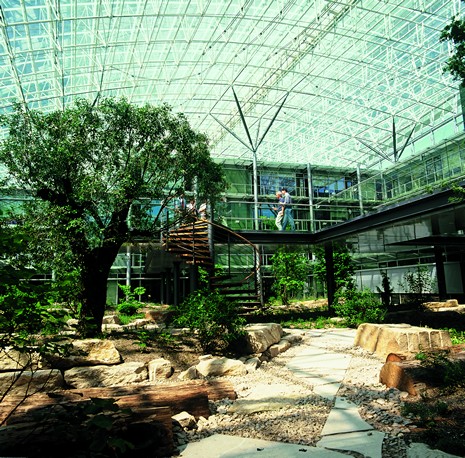Description
As a result of a Europe-wide competition, Hascher + Jehle were awarded the contract for the headquarters of dvg Hanover, Datenverarbeitungsgesellschaft mbH, and in 1997 they began the planning as a joint venture with Heinle, Wischer und Partner.
The 380-metre-long administration building faces south, towards the countryside. Green spaces extend into the interstices between the ‘fingers’ of the structure, so that the building and the landscape interlock. The built volumes covered with three glass roofs and with a southern exposure are optimally orientated in accordance with the passive solar energy design.
In the reception area, the inner arterial avenue begins in the form of a mall that runs through the entire building as the main horizontal axis. Communication areas and lounge areas are situated along this “main street” as are the cafeteria, shops, market stands and an ATM.
In addition to the conception of an open, ‘green’ office landscape that descends into the countryside in the form of a series of terraces, the building’s structure is determined by the T-shaped combi-office units that enable a high degree of internal flexibility and networking for the organisation of working groups. This way, the ideal prerequisites for temporary group structures and spontaneous communication channels were created. However, a building for 1850 workers also requires space for the informal exchange of information. Instead of a rigid office structure, in cooperation with Concept-international a communicative ‘landscape’ was created, in which workers can casually meet and talk outside the organisational and group units.
Large, light-flooded interior courtyards with olive, fig and pomegranate trees offer a visual respite from working at computer screens. Similarly, green plants in the halls contribute to improving the air quality. There is direct access from all the offices to the terraces or the landscaped interior courtyards. Light and shade under the glass roof ensure an ever-changing play of colours. Sun, wind and rain are also perceptible from inside the building, which is characterised by a calm tenor.
In order to achieve optimal use of space for interaction and creativity while at the same time minimising workplace costs, recourse was had to the business club concept as a model for office organisation. The advantages of the combi-office – shared communicative areas with discussion corners, an espresso bar, seating areas, departmental archives, library, etc. – were combined with a mixture of open workplace areas and a number of quiet workrooms. All the workplaces are standardised and networked. As it can be assumed that due to holidays, meetings, seminars, illness etc., an average of about 20-30% of the workplaces will not be occupied, there are fewer workplaces than there are employees. Staff are required to clear (and hence liberate) their desks if they absent themselves for more than a few hours. This way, investment costs and maintenance overheads are drastically reduced.
The structure of the building and its finishes are suitable for exploiting the year-round supply of sun and wind in such a way that the amount of supplementary energy required is minimised. For this reason, the geometry of the built volumes is optimised for flow. Three glass roofs ‘float’ above the office buildings, forming a climatic buffer between the interior and the exterior. With the exception of a few cold winter days, the glass halls can be used for meetings, taking breaks from work or for just spending time. In winter, solar energy admitted by the glass hall contributes to the reduction of heating costs. The function of the glass skin is not to produce an additional space to be heated, but instead to create a climatic shift, providing a climate with all the advantages of a Mediterranean zone with green vegetation year-round. In summer, overheating of the glass building is prevented, in particular, by opening large areas and thus creating an exterior space that is optimally ventilated by natural means.
Additional louvres of solar control glass on the eaves protect the halls from glare, especially from the rays of the sun low on the horizon in the mornings and the evenings. Extensive wind tunnel experiments were carried out relative to ventilation in order to achieve an unobstructed flow of air through these large spaces and to optimise the structural frame.
The temperature of office areas is controlled by a thermo-active ceiling system utilising thermal masses of exposed reinforced concrete. A local thermal power station provides the energy supply for the whole facility.
Drawings
Site plan: The ‘fingers’ of the office areas point towards a park to the south
Ground floor: T-shaped combi-office units extend finger-like into the park landscape
Second floor: detail of a T-shaped combi-office unit
Cross section through a glass-roofed courtyard planted with greenery
Climate control through solar protection and currents of air
Diagram of the terrace structure
Diagram of terraced building design with central axis for access
Each office has its own access to the adjoining landscaped courtyard
Photos

Exterior view of the office terraces with adjacent lakes

Glass-roofed courtyard with Mediterranean gardens
Originally published in: Rainer Hascher, Simone Jeska, Birgit Klauck, Office Buildings: A Design Manual, Birkhäuser, 2002.